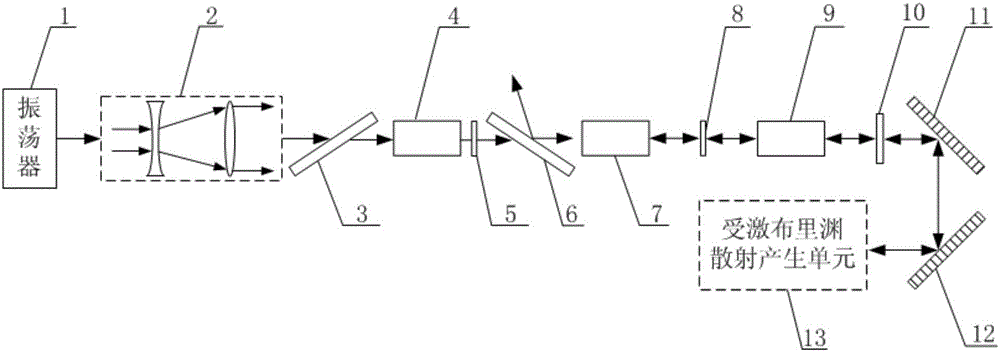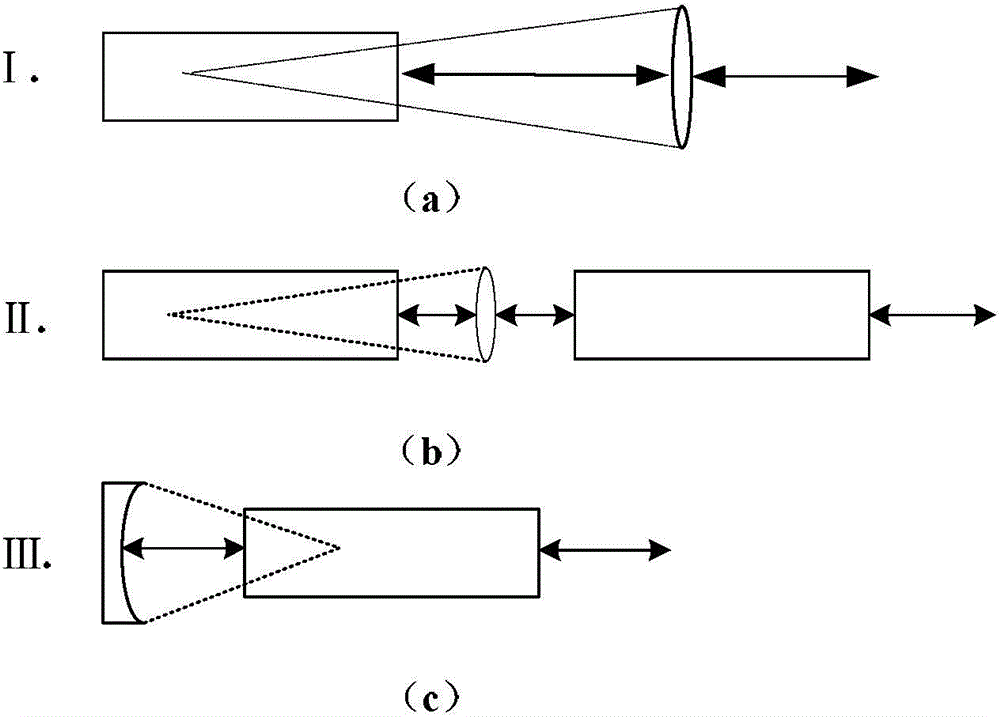High-energy hundreds of picoseconds laser device based on stimulated Brillouin scattering pulse compression
A technology of stimulated Brillouin and picosecond lasers, applied in the field of lasers, can solve the problem that lasers cannot achieve narrow pulse high-energy single longitudinal mode output, and achieve the effect of improving efficiency
- Summary
- Abstract
- Description
- Claims
- Application Information
AI Technical Summary
Problems solved by technology
Method used
Image
Examples
specific Embodiment approach 1
[0016] Specific implementation mode one: the following combination figure 1 Describe this embodiment, the high-energy hundreds of picosecond laser device based on stimulated Brillouin scattering pulse width compression in this embodiment, it includes an oscillator 1, a beam expander telescope 2, a No. 1 polarizer 3, and a Faraday isolator 4. 45° rotor 5, No. 2 polarizer 6, No. 1 laser amplifier 7, 90° rotor 8, No. 2 laser amplifier 9, 1 / 4 wave plate 10, No. 1 plane mirror 11, No. 2 plane mirror 12 and a stimulated Brillouin scattering generating unit 13;
[0017] The No. 1 polarizer 3, the Faraday isolator 4, the 45° rotor 5 and the No. 2 polarizer 6 are sequentially arranged along the optical axis to form an optical isolation system;
[0018] The p-polarized light generated by the oscillator 1 passes through the beam expander telescope 2, and then transmits through the optical isolation system. The transmitted p-polarized light is first amplified by the No. 1 laser amplifier...
specific Embodiment approach 2
[0021] Specific implementation mode two: the following combination figure 2 Describe this embodiment, this embodiment will further explain Embodiment 1, the stimulated Brillouin scattering generating unit 13 adopts a single cell structure, and the stimulated Brillouin scattering generating unit 13 is composed of a convex lens and a Brillouin medium cell, and the incident light passes through The convex lens focuses the incident light into the Brillouin medium pool, and stimulated Brillouin scattering occurs in the Brillouin medium pool near the focal point of the convex lens, and returns back to the original path of the Stokes light. Such as figure 2 (a) shown.
[0022] The length of the Brillouin medium pool is selected from 50cm to 120cm, and the focal length of the convex lens is 20cm to 100cm. The inner diameter of the Brillouin medium pool is selected from 20 mm to 50 mm, the refractive index of the Brillouin medium of the liquid inside the Brillouin medium pool is se...
specific Embodiment approach 3
[0024] Specific implementation mode three: the following combination figure 2 Describe this embodiment. This embodiment will further explain Embodiment 1. The stimulated Brillouin scattering generating unit 13 adopts a compact double-cell structure, and the stimulated Brillouin scattering generating unit 13 is composed of a convex lens and two Brillouin dielectric cells. , one of the two Brillouin medium cells is the amplification cell, and the other is the generation cell. The incident light passes through the amplification cell and is focused by the convex lens to the generation cell. Stimulated Brillouin scattering occurs in the generation cell and near the focal point of the convex lens. The back-to-Stokes light is amplified by the amplification cell and returns along the original path. Such as figure 2 (b) shown.
[0025] The length of the Brillouin medium pool is selected from 50cm to 120cm, and the focal length of the convex lens is 20cm to 100cm. The inner diamete...
PUM
| Property | Measurement | Unit |
|---|---|---|
| Length | aaaaa | aaaaa |
| The inside diameter of | aaaaa | aaaaa |
| Wavelength | aaaaa | aaaaa |
Abstract
Description
Claims
Application Information
 Login to View More
Login to View More - R&D
- Intellectual Property
- Life Sciences
- Materials
- Tech Scout
- Unparalleled Data Quality
- Higher Quality Content
- 60% Fewer Hallucinations
Browse by: Latest US Patents, China's latest patents, Technical Efficacy Thesaurus, Application Domain, Technology Topic, Popular Technical Reports.
© 2025 PatSnap. All rights reserved.Legal|Privacy policy|Modern Slavery Act Transparency Statement|Sitemap|About US| Contact US: help@patsnap.com


